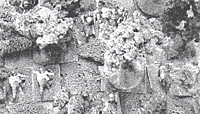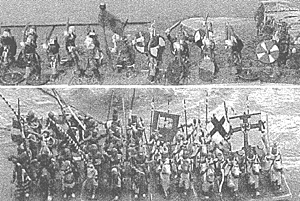 All systems have rules to regulate the effects of terrain. Hardly any rules systems, however, have rules to regulate what terrain will show up at your battle, and where. Why is it that the players and game-masters are expected to select their own terrain for Marlborough, Frederick the Great, Napoleon, Robert E. Lee, and Rommel, while for ancient and medieval generals the rules provide us with our terrain choices? The answer is, and has always been, tournament play.
All systems have rules to regulate the effects of terrain. Hardly any rules systems, however, have rules to regulate what terrain will show up at your battle, and where. Why is it that the players and game-masters are expected to select their own terrain for Marlborough, Frederick the Great, Napoleon, Robert E. Lee, and Rommel, while for ancient and medieval generals the rules provide us with our terrain choices? The answer is, and has always been, tournament play.
Ever since the days when there was only one set of ancient/medieval wargame rules—Mr. Barker didn’t so much come out with different sets of rules as he constantly rewrote them as WRG 1, WRG 2, WRG 3, etc…WRG 7.6—ancient/medieval wargaming has been tied to the British notion of tournament play. Even DBA and DBM—also from the pen of the venerable Phil Barker—were essentially rules for tournament play. Armati, Might of Arms, and Warrior (WRG 7.7) have also gone to the tourneys. I own them all, but alas, play none of them.
So, you may well ask, what is the connection between the tournament nature of ancient/medieval rules systems and terrain? Terrain can be a valuable ally upon the battlefield, or a deadly foe. Terrain is also army specific. It is not a coincidence that the Mongols swept from the plains of Mongolia westward across the steppes of Russia conquering the flat treeless areas of Russia, Poland, Hungary, and eastern Germany, and yet they did not extend themselves into the forests of northern Russia, or the jungles of southern India. Have you ever ridden a horse at speed through a forest? Try doing it while firing a bow from the saddle. The defense rests.
The weapons systems and doctrine of an army dictates the terrain in which it can fight. Take the phalanx. Heavy infantry, overlapping shields, 8 ranks deep of stout fellows with long spears or even pikes. Their success in battle depends upon their maintaining perfect alignment. They are slow moving, awkward, and fearful of their flanks, but give them some smooth open ground, and there will be hell to pay. Name 10 battles in which a phalanx fought in a forest. Name one. It never happened! Go figure.
In ancient/medieval tournaments, however, it can happen every day, three times a day. That may account for the lack of enthusiasm for the armies of the ancient Greeks. Are the players stupid? No. I mean, why take an army that can’t fight in a forest to save itself, into a forest? Well, they didn’t intend to go into a forest. The forest came to them. Could it be Birnum wood moving upon high Dunsinane? Ents?
No, its the rules systems, coupled with malevolent opponents willing to take advantage of anything the rules can provide, even if the rules may not have intended it to happen. As a writer of rules it is inadequate to have good intentions. You must have good rules. I have frequently seen individuals develop a game with a group of friends, and not play-test it on the outside world. Then they take it to a convention, where they lament, “Gee, nobody’s ever done that before!”
I wargame on a 6’ x 12’ table. Using WRG/Warrior Rules with a 15mm army, two players can put down 10 forests, and that’s taking into account the fact that using their terrain generation system, 1/3 of them won’t even happen.
The most common feature on any battlefield was usually high ground. Dirt—to be distinguished with the flat felt covering to which we are accustomed—is not even and smooth, unless you’re the emperor of Persia, and you’ve had an army of extras out there for weeks leveling and raking the area smooth. I always thought there was something advantageous about having the high ground, so I asked many ancients players who use WRG or Warrior why I wasn’t seeing any hills. It seems—you’re not going to believe this—that you can take one of your hills, rises, low ridges, or even knolls, and when you go to place it on the board, a die roll can place it on the enemy’s side of the battlefield, giving him the advantage. Goodbye hills.
Troops took up positions on the battlefield because of the advantages the terrain gave them, or because of the disadvantages the terrain would have given their enemy. Why would an army accept, let alone seek battle in terrain in which it could not fight?
- As rosy fingered dawn peeks over the horizon of the wine dark sea, the Spartan general rises from sleep and says,
“*@(^&@#$!”
“What is it, sir?”
“The hills? I could have sworn that last night when we encamped at the Pass of Thermopylae, that there were steep hills on both sides of us.”
“Ah, sir?”
“Yes?”
“Here come the Persians, sir.”
And so the Spartans gain their 15 minutes of fame…but only 15 minutes…and enter history as a Persian speed bump.
The terrain is rarely neutral. If used properly, it can make almost any weak defense impregnable, or a strong defense very pregnable indeed. Here, a small band of raiding Vikings, who have been caught in the act, prepare to take a stand. They have set down their chickens, penned in their sheep, and stopped rolling the barrel of ale. Now they may have to pay with their lives.
 Here we have a mass of European Knights riding to the rescue of the Peasantry Local #452. With their numbers, speed, and the shock of their impact, they will surely slaughter the Vikings. There’s no way the Vikings can survive.
Here we have a mass of European Knights riding to the rescue of the Peasantry Local #452. With their numbers, speed, and the shock of their impact, they will surely slaughter the Vikings. There’s no way the Vikings can survive.
In WRG/Warrior you don’t know if the terrain is arriving, or even where it’s arriving. Might of Arms, however, does them one worse. In Might of Arms, you get a seemingly limitless number of pieces of terrain, including terrain that is completely impassible—which is probably why they call it impassible terrain. I tried to play in a little local campaign, and found myself playing every single battle in the Teutoberger Wald—couldn’t see the forest through the trees. I rode through the woods on a horse in Nebraska, once, and it was not a pretty sight. (That is, I wasn’t a pretty sight. It probably had nothing to do with either Nebraska or the horse.)
Armati seems to have a less abrasive set of terrain rules, but I have neither played it, nor heard from someone who has, so that’s just a guess from looking at their rules.
Ah, but what happened to the Vikings about to be ridden under by the thundering hooves of the avenging charging knights, you ask? Funny you should ask. Terrain happened. The terrain rules raised the ground beneath the Vikings feet, and wrapped their cliff-top with a swift little river.
The humorists in me chuckles at this. Woody Allen would like this game. The historian and wargamer in me, however, keeps looking for another set of rules.
When the general does not select the terrain upon which he wishes to deploy his army for battle, but has terrain dropped upon him from the sky by the malevolent terrain rules god, then anything can happen, including the case on the previous page, of 2 units of charging knights, perched upon 2 rocky pinnacles. Ridiculous? Yes. But so are many of the ideas behind some of the terrain rules.
 Terrain Placement
Terrain Placement
Now, if I may, I would very much like to offer a few rational thoughts upon terrain placement. I was in a battle as a subordinate mercenary once, and found that the enemy could use his surrealistic terrain catapult to place a massive clump of impassible terrain in the center of our reserve area, so that we could not shift reserve troops from the left to the right, and vice versa. What general would voluntarily take up a position with such a handicap? Then, to make the ridiculous even more so, he proceeded to completely cut off our right flank, by laying down a carpet of impenetrable terrain all across the board with that same dastardly terrain catapult. Fortunately, he failed his die roll on one of them, so our Mongol Corps had a tiny hole in his Great Wall of terrain that we could try to ride through—if it weren’t for his pike blocks that neatly filled it. Frustrating? No, foolish. Will I ride up with my Mongols and bang their little heads against the Great Wall of impenetrable terrain all day? No. I was married to that kind of situation once. I just put down the rules, and slowly backed away.
You may purchase a set of rules, and it may try to take you prisoner, but remember that it is the duty of every officer and gentleman to try to escape.
Now back to a rational thought. If a commander is approaching an enemy, he will do so through terrain that is most compatible with his army. His enemy will do the same. Hence, in the wonderful world of terrain placement, one should be able to choose—within limits—the terrain that will appear upon your own side of the board, and so should your opponent. The idea, the very concept of using some gigantic rules catapult to hurl unacceptable terrain raining down upon the heads of your opponents, is ludicrous! It is the height of stupidity, and makes for an unplayable game!
Historically, Fabius Cunctator introduced his ‘Fabian’ strategy against Hannibal. Essentially, he was always in the area of Hannibal’s army, but always selected such miserable terrain that Hannibal, who dearly loved battle, would not fight him. It strikes me that too many rules sets enable their players to practice Fabian Tactics. The gamers, however, know that no matter how absurd the terrain they select, the circumstances forces their enemy to give battle. Such absurd rules. What scum. How ungentlemanly. OK, we’ve dished enough dirt on terrain rules. So on to the next article.
Back to Novag's Gamer's Closet Spring 2003 Table of Contents
Back to Novag's Gamer's Closet List of Issues
Back to MagWeb Master Magazine List
© Copyright 2003 by Novag
This article appears in MagWeb.com (Magazine Web) on the Internet World Wide Web. Other articles from military history and related magazines are available at http://www.magweb.com